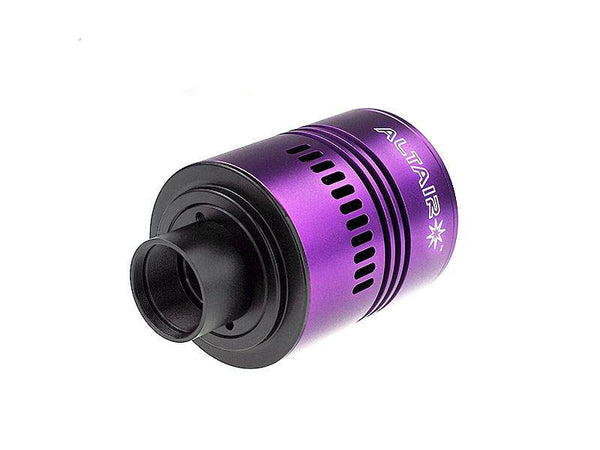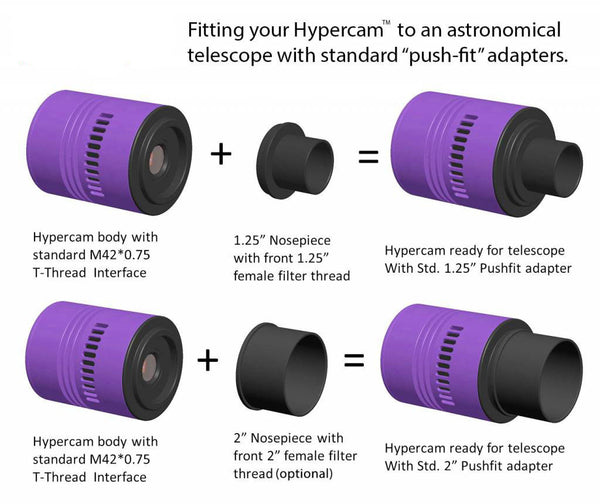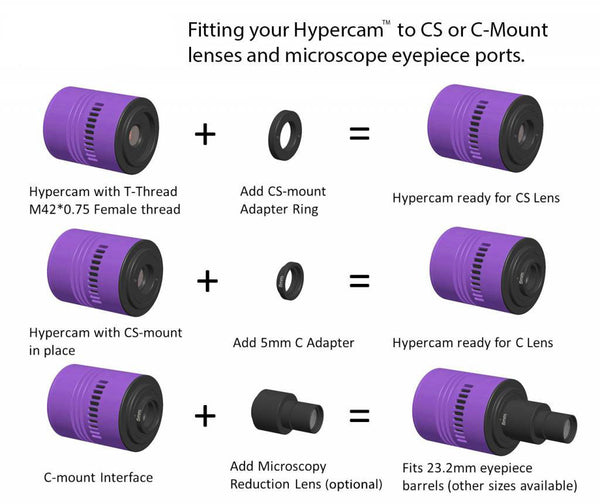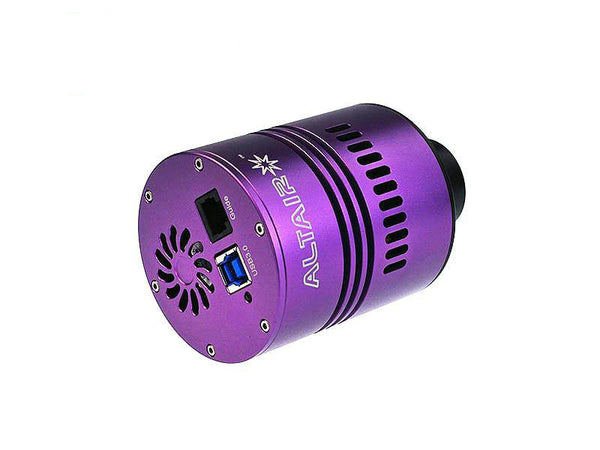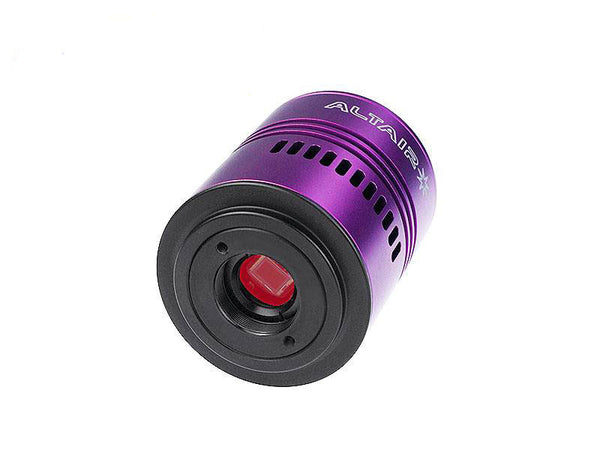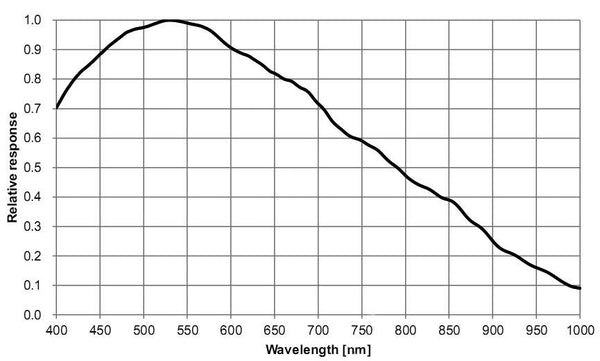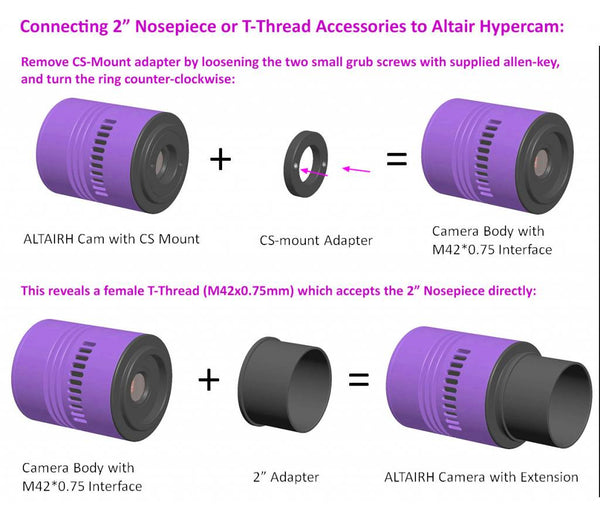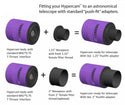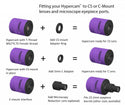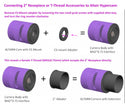The Altair Hypercam IMX178 Mono camera has the sought-after Sony IMX178 CMOS sensor, with extremely low read noise, wide dynamic range, and 6.3mp resolution.
SPECIAL OFFER! FREE 1 year SharpCap PRO License with this camera! Click here for more SC PRO feature info. Just download the latest SharpCap and connect your camera, register when the screen pops up and off you go. Sharpcap PRO has the amazingly accurate guidescope polar alignment routine, focus assistance, live flat field subtraction and many more great features to make deepsky, EAA or solar system imaging that much easier. Download SharpCap here to take advantage of this special offer.
Solar system imaging: The Hypercam IMX178 is also capable of solar. lunar, or planetary imaging (video capture) and is especially useful with refractors of less than 3 metres focal length, where small pixels (only 2.4x2.4um), high frame rates (up to 51fps at full resolution), and low read noise are required to get the most detail in post processing. The ROI (Region of Interest) feature can be used for even higher frame rates when imaging the planets, sun or moon at high magnification. Solar imaging is demanding work for any camera. The Hypercam is the best choice for solar imaging, because the internal fan and heatsink keep all the electronics cool. This reduces the chance of sensor or board glitches caused by excessive heat. Even the camera casing remains suprisingly cool thanks to the fan ventilation.
EAA & Video Astronomy: The Hypercam IMX178 sensor is particularily attractive for Electronically Assisted Astronomy / Video Astronomy because of it's high 6.3 Megapixel resolution and high sensitivity thanks to Sony STARVIS back-illumination and Exmor-R technology.
Deepsky astro-photography: The IMX178 sensor because has very low amp glow, in fact, the lowest of any CMOS sensor in this price range we have developed so far. Amp glow is electronically suppressed onboard, and for EAA/Video astronomy you can effectively remove any remaining amp glow by using the "Live" darkframe subtraction in AltairCapture or SharpCap. For deepsky imaging, you can remove any remaining amp glow in post processing by capturing and subtracking darkframes as usual.
To sum it up, the most desirable features of the Hypercam IMX178 sensor are:
- Large format 1/1.8" sensor 7.37 x 4.92mm
- SONY STARVIS and Exmor R Technology with a sensitivity of 2000 mV or more per 1µm²
- Low read noise, approx. 2.2e electrons (e-).
- Saturation (full well) capacity approx. 15,000 electrons (e-)
- High Dynamic Range with 14 bit ADC for high image quality in both light and dark (high contrast) areas.
Deepsky imaging examples: Hypercam IMX178 delivers good results for for both deepsky imaging and video astronomy (or EAA) using the Live Stacking features in the free AltairCapture software or SharpCap. Time-lapse all-sky imaging and video is fully supported, and the camera can be used with a DSLR lens to image large areas of sky (use Altair DSLR lens adapter, product code beginning with "CLA").
Solar Imaging examples: Being a black and white camera, the Hypercam IMX178 Mono is particularly desirable for solar imaging with filters. You can image the sun in white light (with an Altair Solar Wedge or other filter), Hydrogen Alpha (with a Daystar Quark and refractor or dedicated solar telescope), Calcium or Sodium (with the respective Quark filters). We can advise the best equipment combinations depending on your existing equipment.
To get an idea of what this camera is capable of, here's a solar image with Hypercam IMX178 mono by Nick (of Altair Astro). Click to enlarge (opens new window). A "double stacked" Lunt 60/50mm dedicated solar telescope was used to capture about 100 frames. The IMX178 sensor covers the entire disc of the sun in one frame with this scope, so you don't have to mosaic several frames to capture a detailed image. Because the sun changes so fast, mosaics rarely "hold together" and it's very hard to blend frames, so being able to capture the entire disc simultaneously at high resolution really helps the image to "hang together".
Speed and reliability in one camera: USB3.0 and on-board memory buffering give much faster transfer speeds than the GPCAM USB2.0 series, pushing the USB3.0 format to the limit, yet within a stable envelope. Memory buffering almost completely eliminates dropped frames and corrupted video files, a common problem with USB cameras, and enables faster more consistent frame rates, even with less powerful notebook computers. Consistency and stability is improved for video capture sequences - especially desirable for scientific applications.
QUALITY software and drivers included: Unlike cheaper cameras, Altair Astro has spent considerable time developing the extensively featured and intuitive AltairCapture software, which can be downloaded from cameras.altairastro.com. AltairCapture is a stable 64 bit Windows application, which allows full control of the camera in high speed video or still mode. It includes extensive automation features, and supports all the major file formats useful for astro imaging and professional scientific imaging in 16bit, 14bit or 8bit mode. Furthermore, the popular PHD Guiding, SharpCap and Firecapture (Beta) are also natively supported. ASCOM drivers are also available for download at cameras.altairastro.com where you can also get regular driver updates. The installation process is very simple, and unlike with cheaper cameras, you don't need to be a computer whizz just to make your camera work.
Wide compatibility: Although the Hypercam is a USB3.0 camera, it is also fully compatible with USB2.0 ports when a longer cable and less speed are required, for example in deepsky or video astronomy using the live stacking features in AltairCapture or Sharpcap. Windows 7 to Windows 10 software is widely supported by AltairCapture in 64bit mode (see technical info for details).
Autoguiding: The camera has an ST4 auto-guiding port, and can be used to auto-guide with mounts from all the major manufacturers supporting ST4 format, including iOptron, Celestron and Skywatcher. The IMX224 is more than sensitive enough for autoguiding.
Fan cooling: The Hypercam is cooled with and internal low vibration fan. The fan can be switched on or off and the speed controlled in AltairCapture and SharpCap. Cool air is drawn in through the vents at the side of the casing, over a large internal heat-sink. The heat-sink is connected directly with the sensor board just like a computer CPU. The free flow of air through the casing cools not only the sensor, but all the internal electronics boards. Cooling is especially desirable for long exposure imaging to reduce thermal noise. Some camera casings get uncomfortably hot during a solar imaging session, and the sensor can reach around 60 or even 70 degrees. This can cause the electronics to become glitchy and unreliable. The Hypercam is designed for consistent, reliable solar imaging with a solar filter and diagonal or Hershel Wedge. With the fan running, the Hypercam electronics will always remain cool.
Support & warranty: Altair delivers proper on-shore English-speaking UK/EU support with a 2 year manufacturer warranty against defects in materials and workmanship. Now just try that with a Chinese camera! New users should definitely visit the Altair Astro Google User Group where you can get answers to technical questions, as well as sharing tips and techniques, to get the best out of your camera. The AltairCapture software interface supports most European languages including English, German, French, Indonesian, Japanese, Korean, Polish, Russian, Chinese, Spanish, Thai, and Turkish.
File formats: The camera can be fully controlled in AltairCapture and SharpCap to output uncompressed .AVI and .SER video files for solar system imaging, as well as all common still image formats such as .JPEG .PNG .TIFF .BMP, and .FITS (for deepsky imaging) to mention just a few. The Hypercam supports 8bit or 14bit ADC output. The 14 bit output mode can be used for deep sky imaging with less frames needing to be stacked and a wider pixel intensity range. The sensor is extremely sensitive and a good candidate for video astronomy, especially with small refractors (final .FITS file is stretched to 16bit for post processing compatiblility). Find out more about bit depth here. Find out more about video & file formats here.
What’s different about the Hypercam platform compared to the GPCAM platform? You’ll notice the Hypercam has a larger casing than the GPCAM and GPCAM2. This is to house larger electronics boards which support trigger mode and frame buffering, the additional electronics for USb3.0 support, and to house the fan-cooled large heat-sink.
The Hypercam platform: The Hypercam platform supports “Trigger Mode” to make long exposures of over 5 seconds easier to control. With most cameras, in normal video mode, you have to wait for an exposure to complete before the camera will accept, say a command to abort the frame, for say clouds, aircraft, or an alignment issue, like kicking the tripod and so-on, or for routine changes in gain, exposure time, , re-aligning or refocusing on the object. For long exposures, normal video mode is inconvenient, especially for video astronomy and deep-sky imaging, however in Trigger mode, you can stop the camera instantly (even if you are half way through a long 30 second exposure) change the settings, and re-start the camera looping again. The Hypercam also has an improved on-board frame buffer to improve data transfer stability at high frame rates (to reduce dropped frames) and to increase compatibility with a wider range of PCs. The improved buffers give a more consistent data transfer rate over USB2.0 and USB3.0 buses on laptops and desktop PCs.
Included in the box:
Camera body with internal cooling fan, heat-sink, and front female M42x0.75mm T-Thread interface.
1.8m High-speed USB3.0 cable.
1.5m ST4 guide cable.
1.25 inch x nosepiece with female 1.25" filter thread on the front. (an optional 2" OD Nosepiece is available, code ALTAIRH-2IN)
CS-Mount insert (12.5mm back-focus) is pre-installed on camera. (Optional 5mm extension adapter available for C-Mount lenses requiring 17.5mm back-focus.)
Camera casing with M42 thread (12.5mm backfocus).
Built-in UV-IR Blocking Filter, AR coatings. (Removable for sensor cleaning).
Plastic dust cap 1.25".
Silicon dust cap for sensor.
Allen key for removing the C-Thread insert.
Note: This camera does not come with software in the box. To operate the camera you will need to download the latest camera drivers at cameras.altairastro.com (opens new window)
Sensor & performance specifications:
ALTAIRH178M: SONY Exmor R BSI IMX178 Mono CMOS sensor
Sensor Size: 1/1.8" diagonal (8.92mm)
Exposure duration shortest/longest: 0.244 ms (0.000244 secs) / 5 secs (Video Mode)
0.244 ms (0.000244 secs) / 1000 secs (16.66mins) (Trigger Mode)
Bit depth: 8bit & 14bit mode switchable
Pixel size microns: 2.4x2.4 um
Resolution in pixels: 3040x2048
Recording System: Still Picture and Video
Region of Interest (ROI) support: Available
Approx. Max frame rates* (assuming computer Bus operating at full bandwidth):
8bit mode:
3040x2048 51FPS
640x480 191FPS ROI
320x240 264FPS ROI
14bit mode:
Approx 50% of above
* Based on average user reports. May be revised as we get more data. The shorter the exposure duration, the faster the frame rate. An expensive PC does not guarantee a fast frame rate because PC bus and main board architecture vary.
Sensor QE / Quantum Efficiency:
ALTAIRH178M: N/A
Gain Sensitivity:
ALTAIRH178M: 425mv;
Dynamic Range:
ALTAIRH178M: N/A
SNR Maximum:
ALTAIRH178M: N/A
Readout: Progressive Scan
Shutter: Electronic Rolling Shutter
Software & OS support:
Drivers & AltairCapture software download (Windows only): cameras.altairastro.com (opens new window).
Driver support: PHD2, AltairCapture, SharpCap, (Windows DirectShow)
AltairCapture OS support: Win XP 32bit / Vista/ 7/ 8/ 10 (32 & 64 bit)
SharpCap (a 3rd party application) is also fully supported and tested with native drivers.
Firecapture (a 3rd party application) is being tested with native drivers, see latest release.
USB Port & Cable: 3.0 USB Cable, 1.8m cable
ST4 Port & Cable: Standard ST4 Opto-Isolated, 1.5m cable, iOptron, Celestron, Skywatcher SynScan GOTO.
Camera Format:
Cooling: High Performance Electronic Fan-cooling System with Heat-sink
Camera body length: 80 mm
Weight grams: 320 g (camera net weight)
Optical window can be removed:
Mono Camera: AR-coated clear protect window 350-1050nm wavelength transmission
Colour Camera: AR-coated UV/IR blocking filter 400-700nm wavelength Transmission
Back-focus & Adapter compatibility:
Optical Window is removable for cleaning and can be swapped with a clear window or UV/IR blocking window as required.
Camera body: OD 65mm
Camera body thread: M42x0.75 T2 Thread to CS -Mount insert allows direct attachment of CS-Mount lens (or C-Mount lens with optional 5mm extension).
C-mount lens adapter 5mm extension: Optional
C-mount lens compatibility: C-Mount male threaded lens with 17.5mm back-focus (or flange-distance) requirement.
CS-mount lens compatibility: C-Mount male threaded lens with 12.5mm back-focus (or flange-distance) requirement.
Astro filter thread adapter: Included, 1.25" OD and 2” OD (optional), Female thread
Sensor surface distance from flat end of CS-mount adapter: 12.5 mm
Sensor surface distance from flat end of 1.25" / M42 Astro adapter: 37 mm
Operating environment conditions:
Power consumption: 0.905 W (standby);
1.68 W (running with Fan off);
2.525 (running with Fan on);
Max operating temp: 50 °C
Lowest operating temp: -10 °C
Max operating humidity: 80 % RH
Power source in Volts: 5V DC (via USB cable)
Windows PC Hardware Requirements:
Minimum CPU: Equal to Intel Core2 2.8GHz or Higher
Minimum Memory: 2GB or More
USB port: USB2.0 High-speed Port or USB3.0 High-speed Port
Monitor Display: 17" or Larger
Software delivery: Downloaded online and saved to hard drive.
Packaging:
Protective silicon rubber end-cap for camera CS-thread.
Plastic end cap for 1.25" nosepiece.
Padded cardboard storage box with durable foam inserts
Optional Accessories:
2 inch x 22mm nosepiece with 2” filter thread, code ALTAIRH-2IN.
C-Mount 5mm extension adapter for C-Mount lenses requiring 17.5mm back-focus.
Clear AR coated optical window;
Software delivery: Downloaded online at cameras.altairastro.com and saved to hard drive.
Quick Start & AltairCapture instructions: Downloaded online at cameras.altairastro.com and saved to hard drive.
Warranty: 2 years manufacturer warranty against defects in materials and workmanship. Return to point of purchase.

